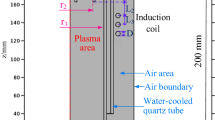Abstract
An analytical and numerical study of the coupling of strip-line antenna with small tokamak plasma is presented with the help of the ICRH antenna code SITAR (Simulation of ICRH anTennaA Resistance). The antenna is of finite poloidal and toroidal dimensions and screened from the plasma by a metal screen of anisotropic conductivity that shorts out the toroidal components of radio frequency electric field. A linear model of refractive index in plasma evanescent region has been considered to describe the propagation of wave in it. The plasma in the coupling region is described by cold plasma dielectric tensors with non-uniform density and toroidal magnetic field along the radial direction. Inclusion of finite antenna length, antenna lead currents as well as toroidal and poloidal variation of current in it (3D analysis) introduces an important difference in the antenna load resistance and inductance compared to those calculations when lead current is ignored and plasma is assumed to be invariant along the poloidal direction (2D analysis). The effect of plasma density, antenna length, wall and plasma edge distances on antenna load resistance and inductance has been studied using parameters of Aditya-U and SST-1 tokamaks.





Similar content being viewed by others
References
P Dumortier and A M Messiaen, Fusion Sci. Technol. 61(2T), 320 (2012)
A K Chattopadhyay, Report, Institute for Plasma Research IPR_RR-1392 (2022)
A K Chattopadhyay, IEEE Trans. Plasma Sci. 51(4), 1188 (2023)
V P Bhatnagar et al, Nucl. Fusion 22, 280 (1982)
A K Dash and A K Chattopadhyay, Fusion Sci. Technol. 77, 67 (2021)
R L Tanna et al, Nucl. Fusion 59, 112006 (2019)
Y C Saxena and SST-1 Team, Nucl. Fusion 40, 1069 (2000)
V Lancellotti et al, Nucl. Fusion 46, S476 (2006)
A Messiaen et al, Nucl. Fusion 50, 025026 (2010)
S Pecoul et al, Comput. Phys. Commun. 146, 166 (2002)
M Brambilla, Plasma Phys. Control Fusion 31, 723 (1989)
M D Carter et al, Nucl. Fusion 36, 209 (1996)
T H Stix, Waves in plasma (American Institute of Physics, New York, 1992).
M Brambilla, Kinetic theory of plasma waves – Homogeneous plasma (Oxford University Press, New York, 1998)
A Ram and A Bers, Nucl. Fusion 24, 679 (1984)
A Bers, L P Harten and A Ram, Proc. 4th Top. Conf. on Radio-Frequency Plasma Heating (University of Texas, Austin, TX, 1981) paper A16
M J Mayberry et al, Nucl. Fusion 30, 579 (1990)
R R Weynants et al, Heating in toroidal plasmas, Proc. 2nd Joint Grenoble-Varenna Int. Symp. Como. Vol. 1, p. 487 (1980)
Author information
Authors and Affiliations
Corresponding author
Rights and permissions
About this article
Cite this article
Chattopadhyay, A.K. Analysis of the coupling characteristics of ion cyclotron resonance heating antenna of small tokamak with the help of 2D and 3D antenna codes. Pramana - J Phys 97, 125 (2023). https://doi.org/10.1007/s12043-023-02604-2
Received:
Revised:
Accepted:
Published:
DOI: https://doi.org/10.1007/s12043-023-02604-2
Keywords
- ICRF antenna code
- SITAR
- simulation of ICRH antenna resistance
- strip-line antenna
- Aditya-U and SST-1 antenna coupling




